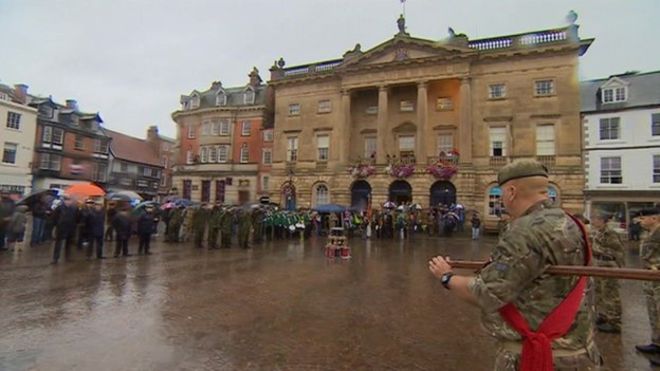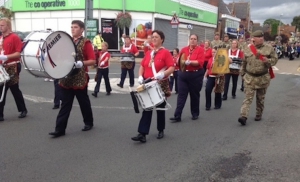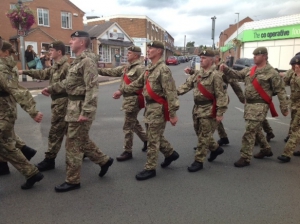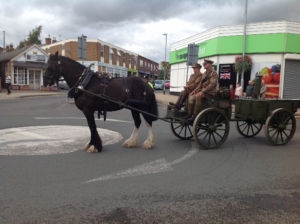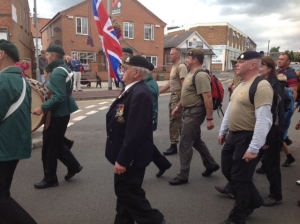Re-enactment of Newark March,
August 10th 2014
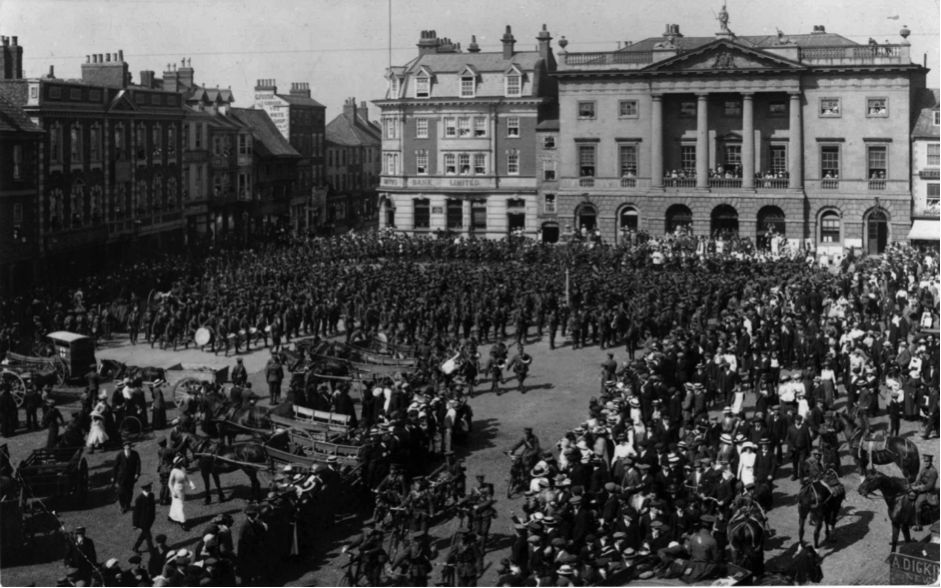
Photographs showing the Newark muster of the 1/8th Bn, The Sherwood Foresters in 1914 and its recreation in 2014
On August 10th 2014, a hundred and fifty military and civilian walkers assembled in Newark Square for a drum head service to commemorate the 100th anniversary of the raising of the 1/8th Sherwood Foresters. They then marched off in a downpour to Radcliffe on Trent, led by the 4th Battalion (Army Reserve) from the successor Mercian Regiment.
Background to re-enactment of the march
When war was declared on August 4th 1914, reservists and territorials were called up immediately. ‘Musters’ took place around the country, including one in Newark Square on August 10th for the 1/8th Bn. (Territorial Force) Sherwood Foresters. The newly mobilised men paraded in front of packed crowds at Newark before marching off to war – via Radcliffe on Trent. Their makeshift regimental transport included bread carts, horses purchased from local farms and a furniture van full of blankets.
The 1/8th Sherwood Foresters reached Radcliffe on Trent some hours later where they stayed the night. ‘Other ranks’ slept in private dwellings and at the Co-op Hall, above the store. Officers were billeted at Lamcote House, the home of Lt. Colonel Birkin who commanded the ‘Robin Hoods’ (1/7th Battalion, The Sherwood Foresters). Cheering crowds in Nottingham applauded the Robin Hoods when mustered the same day before they marched off to Derby. The following day, August 8th, the 1st/8th went on from Radcliffe to Derby, via Nottingham, to join the 1st/7th. They left at 7.30 a.m. and proceeded by the Holme Pierrepont Road to Trent Bridge. Their route through the city was via Arkwright Street, Carrington Street and along Castle Boulevard. After a short break they continued along Lenton Boulevard and out to the main Derby Road. The Nottingham Evening Post report of August 11th states that many spectators watched their departure and several soldiers were suffering from the effects of a long march the previous day in the heat. Three days later the men were transported from Derby to Hertfordshire for six months training before arriving in France in February 1915. The 1/5th, 1/6th, 1/7th and 1/8th Battalions of the Sherwood Foresters formed the 139th (Notts.and Derby) Brigade of the 46th (North Midland) division. Their headquarters were at Fonquevillers (nicknamed Funky Villas), France, from 1916.
Newark March to Radcliffe on Trent, August 2014
Radcliffe Parish Council hosted serving soldiers from 4 Mercian, cadets, St Edmund’s drum and bugle corps from Mansfield Woodhouse, scouts and members of the public who joined the seventeen mile commemorative walk from Newark. Several of the public were descendants of the men who were called up in Newark in 1914, including 79 year old John Green who walked the whole distance. His father was in the original march. Sadly, the dedicated organiser of the march, 69 year old Walter Hurst, was too ill to be present and died in late September.
The Nottingham Post report on August 11th 2014 included the following quotes from walkers: ‘Lieutenant Lloyd Watts, 28, a Nottingham teacher in his day job, said: “In spite of the weather, we kept up our morale. It would have been hard to complain because the guys were here to replicate something done by men who had much worse to endure.” Private Joe Giddings, 25, of Beeston, added: “We got to the end of the march but so many of them didn’t get to the end of the war”‘.
On arrival and after refreshments, the walkers marched into Radcliffe to the band playing ‘Pack up your Troubles’ and ‘It’s a long way to Tipperary’. A drum service attended by a large crowd from Radcliffe was held in the grounds of Grange Hall, close to the British Legion where the Radcliffe centenary exhibition was hosted.
A hundred years previously, Captain Weetman had described the 1914 muster and march:
On Monday, August 10th, at 9.30 a.m., we paraded in the Market Place ready to begin our move to concentration areas. The Mayor (Mr. J. C. Kew) and Corporation were present, accompanied by Canon Hindley, Vicar of Newark, and other Clergy, and there was a dense crowd of onlookers. After an address by the Mayor, who wished us God speed, and a short service, we marched off via the Fosse Way to Radcliffe-on-Trent, leaving behind H Company under Capt. Becher, to guard the railway.
For the first time in its history the Battalion had complete First Line and Train Transport with it, this being under the command of Lieut. Davenport, who had been appointed Transport Officer. The vehicles were not exactly regulation pattern, but little fault could be found with the horses, all of which had been purchased locally. Floats from Warwick and Richardson’s and Hole’s formed the majority of the Small Arm Ammunition and tool carts, whilst Dickens’s Mineral Water drays and Davy’s Brewery drays made fairly good General Service wagons, when fitted with light wooden sides. A furniture van full of blankets, two Corporation water carts, and a bread cart with a large red cross on each side, completed the collection. We feel sure that few Regimental Transports can have looked more like a circus than did ours as we left Newark.
The march of 14 miles to Radcliffe-on-Trent was completed about 4 p.m., and after a good night’s rest we left early on August 11th, and proceeding via Nottingham, arrived at Derby at 6.30 p.m., after a 23 mile march. This was a very severe test for all, as few were really “hard” enough at that time for such a long trek. Route marches were accordingly carried out, on each of the three extremely hot days spent at Derby, as the main part of our programme.’

